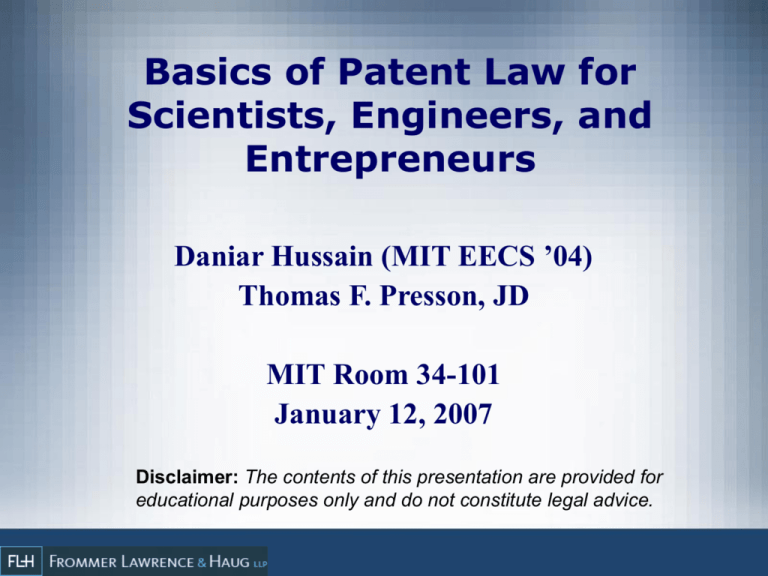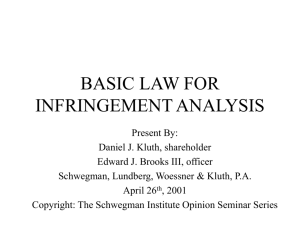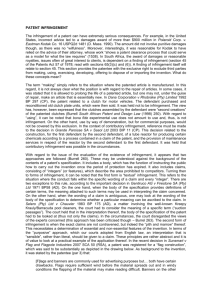patent_law_1
advertisement

Basics of Patent Law for Scientists, Engineers, and Entrepreneurs Daniar Hussain (MIT EECS ’04) Thomas F. Presson, JD MIT Room 34-101 January 12, 2007 Disclaimer: The contents of this presentation are provided for educational purposes only and do not constitute legal advice. Table of Contents • Part I: Foundations of Patent Law Tom Presson • Part II: Patentability Dan Hussain FEDERAL PATENT GRANT PROVIDED IN U.S. CONSTITUTION • The U.S. Constitution authorized the Congress “To promote the progress of . . . useful arts, by securing for limited Times to . . . inventors the exclusive rights to their . . . discoveries.” – Art. I, § 8, clause 8 SPECIFICATION • “The specification shall contain a written description of the invention, and of the manner and process of making and using it, in such full, clear, concise, and exact terms as to enable any person skilled in the art to which it pertains, or with which it is most nearly connected, to make and use the same, and shall set forth the best mode contemplated by the inventor of carrying out his invention.” 35 U.S.C. § 112 paragraph 1. PARTS OF THE SPECIFICATION • Background: sets up the “problem” or “sales pitch” for why invention is patentable. • Objects and/or Summary: should parallel the claims; announces that invention is an advance or a solution, but should not state that invention must achieve that solution. PARTS OF THE SPECIFICATION • Detailed Description: written description that enables the skilled artisan to make and use the claimed invention, and sets forth the best mode known to inventors. • Examples: how invention was worked, or can be worked; actual work performed. • All parts of the application other than the claims, is called the “specification.” DRAWINGS • Drawings are required if they are necessary to understand the invention. CLAIMS: PARAMOUNT IMPORTANCE Statutory Requirement for Claims • “The specification shall conclude with one or more claims particularly pointing out and distinctly claiming the subject matter which the applicant regards as his invention.” 35 U.S.C. § 112 paragraph 2. Theories of Claim Function • Public Notice • Design-Around • Defines Patentee’s Rights The Patent Right • • • • Patents Grant a Right to Exclude A Right to Exclude Everyone In the United States From – Making – Using – Selling – Offering for Sale – Importing • The patented invention THE REST OF THE PATENT RELATES TO THE CLAIM • The CLAIM is the most important part of a patent application. All parts of a patent application can be relied upon to support the CLAIMS. The Claim as an Offensive and Defensive Tool: The Sword vs. The Shield The Claim as the Sword: • Litigation to enforce the rights of the patentee, within the scope of the claims 35 U.S.C. § 271(a): “whoever without authority makes, uses, offers to sell or sells any patent invention, within the United States or imports into the United States any patented invention during the term of the patent therefor, infringes the patent” The Claim as the Shield: • Prosecution to block others from usurping the rights of the patentee, within the scope of the claims Types of Claims • Composition of matter • Process/Method • Improvements (Jepson claims) • Apparatus/Machine/Device • Article of Manufacture/Product-by-Process • Markush claims Parts of A Claim • Preamble – Introductory name for a claimed subject matter, such as “A composition…” or “A nucleic acid sequence” or “A method of treating” a disease. Transitional Phrase – Bridge between the preamble and the body of the claim and usually selected from one of the following: • “comprising” or “which comprises”: broadest, open-ended, – covers the specified components in the body of the claim and also any additional components • “consisting of” or “which consists of”: narrowest, closed-ended. – A claim with this transition protects only the specified components. If additional components are included, the claim is not literally infringed Transitional Phrase • “consisting essentially of” or “which consists essentially of”: intermediate in scope. – A claim with this transition excludes additional, unspecified components that would affect the basic and novel characteristics of the subject matter defined in the body of the claim. Openended to some extent, closed-ended to some extent Claim Body – Recites the various components required for the invention to be operable and patentable over the prior art. – Process claim: the body is step (1), step (2), step (3), etc. – Apparatus claim: the body is element (1), element (2), etc. Claim Body – Each component in the body should include: • Name • Distinctive features, if any: as a general rule, one should describe everything about the element that is important for the claimed invention • Cooperation, if any, with other components Examples of claims Example 1: Composition of matter What is claimed is (or I/We claim): 1. A composition comprising a solid, a liquid, and a gas. – Claim 1 is an independent claim, because it does not rely on a preceding claim. Examples of claims 2. The composition of claim 1, wherein the solid is a salt. – Claim 2 is a dependent claim, because it refers back to and further limits an independent claim. 3. The composition of claim 2, wherein the salt is sodium chloride. – Dependent claims can depend from other dependent claims. Claim Drafting: The Funnel Breadth of disclosure – Background and Invention Believed area where art permits; claims that will be allowed Goal: claims as filed are granted – independent claims as broad as prior art allows, and as narrow as examples Actual experimentation/examples Preferred embodiments (dependent claims) Examples of Claims Example 2: Method/Process What is claimed is (or I/We claim): 1. A method of producing human protein ‘X’, comprising the steps of: a) transforming or transfecting suitable host cells with a recombinant DNA molecule comprising a nucleotide sequence which codes for human protein ‘X’; b) culturing the host cells of step (a) under conditions in which said cells express the recombinant DNA and produce human protein ‘X’; and c) recovering said human protein ‘X’. Dependent Claims • “A claim may be written in independent or, if the nature of the case admits, in dependent or multiple dependent form. • Subject to the following paragraph, a claim in dependent form shall contain a reference to a claim previously set forth and then specify a further limitation of the subject matter claimed. A claim in dependent form shall be construed to incorporate by reference all the limitations of the claim to which it refers.” 35 U.S.C. 112. Means-Plus-Function Claims • An element in a claim for a combination may be expressed as a means or step for performing a specified function without the recital of structure, material, or acts in support thereof 35 U.S.C. 112 paragraph 6. • Means plus function claims are construed to cover the corresponding structure, material, or acts described in the specification and equivalents thereof. 35 U.S.C. § 112, paragraph 6. Basic Infringement Example • The claim – An apparatus, comprising: A, B, and C. • The infringing product contains: – A, B, and C • Infringement – A and B • No infringement – A, B, C, D and E • Infringement Consequences of Infringement • • • • Lost profits Reasonable royalties Treble damages for willful infringement Injunction Claim Construction – Ordinary and Customary Meaning • 1. “Words of a claim are generally given their ordinary and customary meaning.” • 2. The ordinary and customary meaning that the term would have to a person of ordinary skill in the art in question at the time of the invention, i.e. as of the effective filing date of the patent application. • Phillips v. AWH Corp., 415 F.3d 1303, 1313 (Fed. Cir., en banc 2005) SPECIFICATION • Second, it is always necessary to review the specification to determine whether the inventor has used any terms in a manner inconsistent with their ordinary meaning. The specification acts as a dictionary when it expressly defines terms used in the claims or when it defines terms by implication. PROSECUTION HISTORY • Third, the court may also consider the prosecution history of the patent, if in evidence. This history contains the complete record of all the proceedings before the Patent and Trademark Office, including any express representations made by the applicant regarding the scope of the claims. As such, the record before the Patent and Trademark Office is often of critical significance in determining the meaning of the claims. Included within an analysis of the file history may be an examination of the prior art cited therein. PHILLIPS v. AWH Phillips I • The court stated the intrinsic evidence would control the meaning of a claim term if “the patentee distinguished that term from prior art on the basis of a particular embodiment, expressly disclaimed subject matter, or described a particular embodiment as important to the invention.” • The court looked first to the specification “to ascertain the meaning of a claim term as it is used by the inventor in the context of the entirety of his invention.“ Id. at 1213. The New Approach To Claim Construction • “We have made clear, moreover, that the ordinary and customary meaning of a claim term is the meaning that the term would have to a person of ordinary skill in the art in question at the time of the invention, i.e., as of the effective filing date of the patent application.” Id. DOCTRINE OF CLAIM DIFFERENTIATION • “Because claim terms are normally used consistently throughout the patent, the usage of a term in one claim can often illuminate the meaning of the same term in other claims. • Differences among claims can also be a useful guide in understanding the meaning of particular claim terms. For example, the presence of a dependent claim that adds a particular limitation gives rise to a presumption that the limitation in question is not present in the independent claim.” Id. at 1314-15. THE ROLE OF THE SPECIFICATION • “The descriptive part of the specification aids in ascertaining the scope and meaning of the claims inasmuch as the words of the claims must be based on the description. The specification is, thus, the primary basis for construing the claims.” Id. at 1315 (quoting Standard Oil Co. v. Am. Cyanamid Co., 774 F.2d 448, 452 (Fed.Cir.1985) ) THE ROLE OF THE PROSECUTION HISTORY • “Like the specification, the prosecution history provides evidence of how the PTO and the inventor understood the patent.” Id. at 1317. • “Yet because the prosecution history represents an ongoing negotiation between the PTO and the applicant, rather than the final product of that negotiation, it often lacks the clarity of the specification and thus is less useful for claim construction purposes.” Id. THE ROLE OF EXTRINSIC EVIDENCE • Extrinsic evidence may be useful to the court, but it is unlikely to result in a reliable interpretation of patent claim scope unless considered in the context of the intrinsic evidence” THE ORDER OF INTERPRETATION • The Claims Themselves – Given their ordinary meaning as viewed by a person having ordinary skill in the art at the time of filing. • The Specification – Own Lexicographer – Gives Context to the Claims – Avoid Importing Limitations • The Prosecution History – Clearly Disclaims Scope • Extrinsic Evidence – Informs the Judge of Ordinary Meanings in the Art INFRINGEMENT • Patent infringement requires that the accused product contain each claim limitation or its equivalent. • Literal infringement exists where each claim limitation is met literally by the accused product. Literal Infringement • The patentee must prove that the allegedly infringing product or method embodies every element of the asserted claim(s). Townsend Engineering Co. v. Hitec Co., 829 F.2d 1086, 1090 (Fed. Cir. 1987) • This follows from the principle that “[e]ach element contained in a patent claim is deemed material to defining the scope of the patented invention.” Lemelson v. United States, 752 F.2d 1538, 1551 (Fed. Cir. 1985) • Thus, “[I]f even one limitation is missing or not met as claimed, there is no literal infringement.” Mas-Hamilton Group v. LaGard, Inc., 156 F.3d 1206, 1211 (Fed. Cir. 1998) DOCTRINE OF EQUIVALENTS • The doctrine of equivalents is an alternative theory of infringement available to a patentee. The doctrine may expand a patent claim beyond its literal scope of coverage to encompass an accused product that does not literally infringe. • The doctrine is based on the idea that an infringer should not be permitted to escape liability by merely changing insubstantial details of an invention while retaining the essential identity of the invention. FUNCTION-WAY-RESULT TEST • Graver Tank & Mfg. Co., Inc., v. Linde Air Prods. Co., 339 U.S. 605 (1950). • The Tripartite Identity Test: – “[A] patentee may invoke [the doctrine of equivalents] to proceed against the producer of a device ‘if it performs substantially the same function in substantially the same way to obtain the same result.” Id. at 608. THE ALL-ELEMENT RULE • The All-Element Rule: • The doctrine of equivalents must be applied to individual elements of a patent claim, not to the invention as a whole. PURPOSE OF THE ALL-ELEMENTS RULE • Is a candle the equivalent of a light bulb? • Function: – To provide light • Way: – Light bulb – converts non-light energy (electrical) to light energy – Candle – converts non-light energy (chemical) to light energy • Result: – Both get hot – Both provide light PURPOSE OF THE ALL-ELEMENTS RULE • This is viewing the invention as a whole, and not the individual elements. • A light bulb requires electrons, a wire, a filament, and a covering. • A candle requires a substrate, a wick, a flame, and oxygen. • Electrons and the substrate are not equivalent, and the wire and the wick are not equivalent. PROSECUTION HISTORY ESTOPPEL • Prosecution history estoppel is a limitation on the doctrine of equivalents. Under Festo, it may bar application of the doctrine of equivalents when a claim is narrowed for any reason related to patentability. • Prosecution history estoppel was created by the Supreme Court in Shepard v. Carrigan, 116 U.S. 593 (1886). PROSECUTION HISTORY ESTOPPEL • The “estoppel” here is the following: where the original application once included a potential equivalent, but the patentee narrowed the claim to obtain the patent, the patentee generally cannot assert the surrendered equivalent in an infringement suit. • This means that a patentee cannot recapture what it gave up to succeed in obtaining a patent from the Patent Office. PRIOR ART AND PUBLIC DEDICATION RULE • The DOE may not be used to give a claim scope that will read on a prior art reference. • If the patentee could not have obtained a literal claim from the PTO with this scope, then the DOE should not expand the scope to include this interpretation. • A patentee may not obtain a claim scope under the DOE that covers embodiments disclosed in the specification that are not claimed. Johnson & Johnston Assocs. v. R.E. Serv. Co., 285 F.3d 1046 (Fed. Cir. 2002) PRESUMPTION OF SURRENDER • A narrowing amendment made to satisfy any requirement of the Patent Act results in a rebuttable presumption that prosecution history estoppel bars application of the doctrine of equivalents as to the amended claim element. The patentee may rebut the presumption that the amendment surrenders the particular equivalent at issue. See Festo, 535 U.S. 722 (2002) (“Festo II”). THE LESSON • Draft the patent application to disclose foreseeable species within a broad genus. If first claimed genus is rejected, amendment to a species may be made without drawing a new matter rejection. • Even if amendment draws new matter rejection, file a continuation-in-part application to disclose the new matter and claim foreseeable matter. – Note: Priority date for new matter will be CIP filing date. THE LESSON • Equivalents may be unavailable even if amendment not required to distinguish from other disclosed embodiments – Amendment absent rebuttal/explanation against rejection may foreclose resort to equivalents – Even unamended claims may be limited to literal scope if they contain same “critical” limitations as amended claims THE LESSON • Foreseeability Test – Equivalent is foreseeable even if amendment is not made specifically to avoid prior art reference – To succeed patentee must show that equivalent was unforeseeable at time of amendment — not at time of filing application THE LESSON • Tangential Test – Careful review and study of intrinsic prosecution history is important to successful rebuttal of presumption • “Some Other Reason” Test – Subject to further refinement – Could involve a reasonableness inquiry, including examination of extrinsic evidence (applied here — but Fed. Cir. has not recognized yet) CLAIM DRAFTING: FORESEEABILITY INQUIRY • Evaluate scope and field of invention at important points during prosecution. • Try to draft patent description and claims to cover what could be later judged as foreseeable matter. • “Foreseeability” will be analyzed as of time of the amendment, not at the time the application was filed. Thank you
![Introduction [max 1 pg]](http://s3.studylib.net/store/data/007168054_1-d63441680c3a2b0b41ae7f89ed2aefb8-300x300.png)





